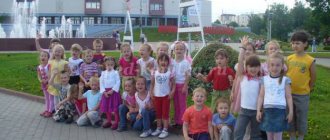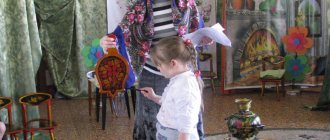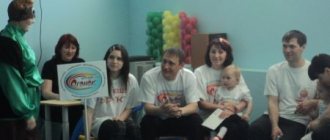Types of theatrical activities in each age group
Category: Consultations Updated 02/17/2017 11:09 Created 02/10/2015 20:52 Author: Erantseva Oksana Aleksandrovna Views: 19738
All theatrical games can be divided into two main groups: dramatization and director's. In dramatization games, the child, playing a role as an “artist,” independently creates an image using a set of expressive means.
Types of dramatization are: games - imitations of images of animals, people, literary characters. Dramatization games are role-playing dialogues based on text. But in director’s play, the “artists” are toys or their substitutes, and the child, organizing the activity as a “scriptwriter and director,” controls the “artists.” “Voicing” the characters and commenting on the plot, he uses different means of expression.
The types of director's games are determined in accordance with the variety of theaters used in kindergarten: tabletop, flat and volumetric, shadow puppet, finger theater, etc. In order to develop the independence and creativity of children in the process of theatrical activities, it is necessary to highlight several conditions:
Enrichment of the environment with attributes of theatrical activities and free exploration of this environment by children (mini theater, which is periodically replenished with new attributes and decorations);
- the content of games should correspond to the interests and capabilities of children;
- meaningful communication between teacher and children;
- the theatrical and play environment should be dynamically changing, and children take part in its creation;
- teaching children expressive means of theatrical activities:
Intonation is a change in voice. This technique helps children turn into Pinocchio, Cinderella, a bear and a hare, Barmaley, Doctor Aibolit, etc.
Facial expressions tell us without words about certain feelings and moods of a person, that is, when a face expresses any emotions.
Gestures are dynamic movements of the body: arms, legs, head, etc., as well as posture.
Pantomime is facial expressions combined with gestures.
In early preschool age, the teacher creates conditions for individual director's games by saturating the object-play environment with small figurative toys (dolls, nesting dolls, animals, technical toys, construction sets, furniture, etc.). The teacher’s participation in individual director’s games is manifested in his acting out everyday and fairy-tale situations (from nursery rhymes, works by V. Berestov, E. Blaginina, etc.), demonstrating the use of role-playing speech, onomatopoeia, drawing the child into the game, prompting lines, and explaining actions.
In the middle group, the teacher creates conditions for collective director games. In an object-play environment, in addition to imaginative toys, there should be a variety of waste materials (boards, spools, unbreakable bubbles, etc.), which contribute to the development of imagination and the ability to act with substitute objects. When organizing director's games, the teacher takes the position of an assistant: asks the child to explain the meaning of the actions, encourages role-playing speech (“What did you say?”, “Where did you go?”), sometimes acting as a bearer of gaming skills, showing fantastic stories with the help of toys and substitute objects. helps the child get involved in such activities.
Senior preschool age is the heyday of directing play, which becomes a full-fledged joint activity. The content of the games are fantastic stories in which reality is intertwined with events from cartoons and books. The subject-game environment for director's games is constructed on the basis of multifunctional game material (a map-layout of the game space). Its use helps the child to invent and act out the events that make up the plot outline, imagine the plot situation even before it is played out, and then flesh it out in the process of director's play, filling it with game events. The similarity of the structure of the game and fairy tale plots makes it possible to use a literary fairy tale as a basis for the development of plot development.
In each age group, it is desirable to have a corner for theatrical performances and performances. They provide space for director's games with finger, table, stand, theater of balls and cubes, costumes, and mittens. In the corner are located:
- various types of theaters: bibabo, tabletop, puppet theater, flannel theater, etc.;
- props for acting out skits and performances: a set of dolls, screens for a puppet theater, costumes, costume elements, masks;
- attributes for various playing positions: theatrical props, makeup, scenery, director's chair, scripts, books, samples of musical works, seats for spectators, posters, box office, tickets, pencils, paints, glue, types of paper, natural material.
Classification of theatrical games
In children of primary preschool age, primary development of director's theatrical play is noted through:
- tabletop toy theater;
- tabletop flat theater;
- flat theater on flannelgraph;
- finger theater
At the age of 4-5 years , a child masters different types of tabletop theater:
- soft toys;
- wooden theater;
- cone theater;
- folk toy theater;
- planar figures;
- theater of spoons;
- horse puppet theater (without a screen, and by the end of the school year - with a screen), etc.
In the senior and preparatory age groups , children can be introduced to puppets, “living hand” theater, handkerchief theater, and people-dolls.
Preview:
"The Wonderful World of Theater"
Project: “Social and communicative development of preschool children through theatrical activities” (middle group)
Relevance: One of the main directions of the kindergarten’s work with preschoolers and their families is the creation of conditions conducive to the child’s successful adaptation to social reality through the development of social and communicative spheres of activity. This direction of work has been confirmed in modern educational innovations: Order of the Ministry of Education and Science of Russia dated October 17, 2013. No. 1155 “On approval of the federal state educational standard for preschool education.” The Federal State Educational Standard for preschool education determines the mandatory minimum content of the program, which is implemented in preschool educational institutions.
Such special attention to the social and communicative development of a modern preschooler is due to the fact that this period of child development is one of the important stages in personality development. This is the initial period of a child’s socialization, his introduction to cultural and universal values, the time when intrapersonal and interpersonal relationships with adults and peers begin to be built.
The social and communicative development of preschool children is multifaceted, complex and often delayed in time. Therefore, the goal of adults is to help children adapt to the modern world, which is characterized by complex, dynamic, negative experiences and manifestations.
Goal: Mastering initial ideas of a social nature and including children in the system of social relations through theatrical activities.
Learn the rules of polite behavior.
Reinforce and apply polite, magic words in life situations.
Develop the ability to act correctly in specific cases.
To increase parents' interest in enrichment, making different types of theater with their own hands
Enrich parents' knowledge about ways to play games at home with their children;
Cultivate goodwill, politeness, emotionality, empathy and willingness to help.
Develop primary skills in the field of theatrical art (use of facial expressions, gestures, voice, puppeteering)
- mastering the norms and values accepted in society, including moral and moral values;
-development of communication and interaction of the child with adults and peers;
- formation of independence, purposefulness and self-regulation of one’s own actions;
-development of social and emotional intelligence, emotional responsiveness, empathy, formation of readiness for joint activities with peers, formation of a respectful attitude and a sense of belonging to one’s family and to the community of children and adults in preschool educational institutions;
- to awaken children’s interest in theatrical activities;
-instill primary skills in the field of theatrical art.
-formation of the need for private individual communication with children.
Enriching teaching skills, maintaining parents’ confidence in their own teaching capabilities;
- to awaken interest in the theater.
- to interest parents in enrichment, making different types of theater with their own hands, decorations for productions, purchasing theatrical costumes.
-increasing the qualified level of self-training;
-providing advisory and practical assistance to parents, problems of upbringing, development and adaptation of the child to preschool educational institutions;
- development of a unified style of education and communication with the child in the preschool educational institution and family.
Stages and deadlines for their implementation
Increasing the level of qualifications on this topic of self-education.
Purchasing additional literature.
Introduce programmatic works, the basics of theatrical activity based on reading fiction. Teach proper behavior with peers and adults. Teach polite words and the correct use of these words through theatrical skits, sketches, and games.
2.Basic. Making a traveling book about the role of theatrical games in the development of a child’s personality. .Conducting parent meetings and consultations for parents. Open demonstration of the “Magic Words” lesson.
3. Final stage - Showing a theatrical fairy tale.
Product: Exhibition of joint drawings. parents and children on the topic: Through the pages of fairy tales.
Mini film of the joint theater project “Magic Words”.






